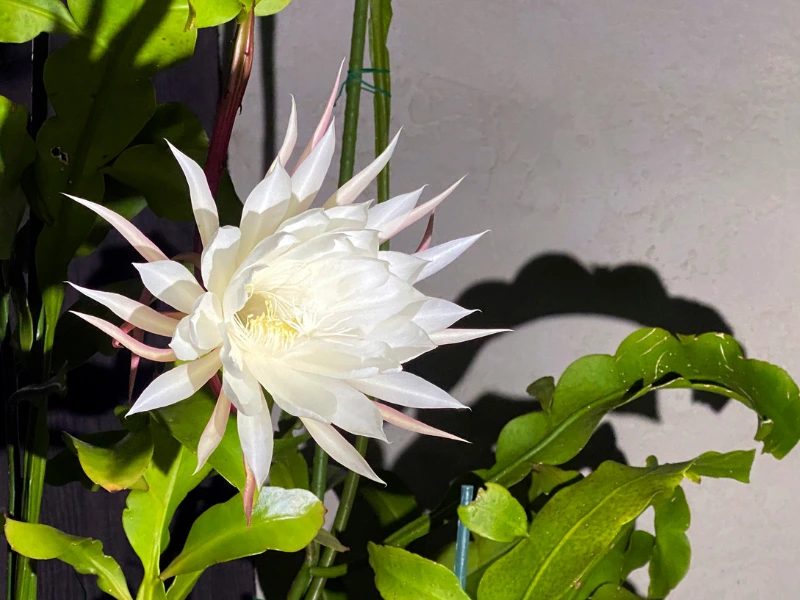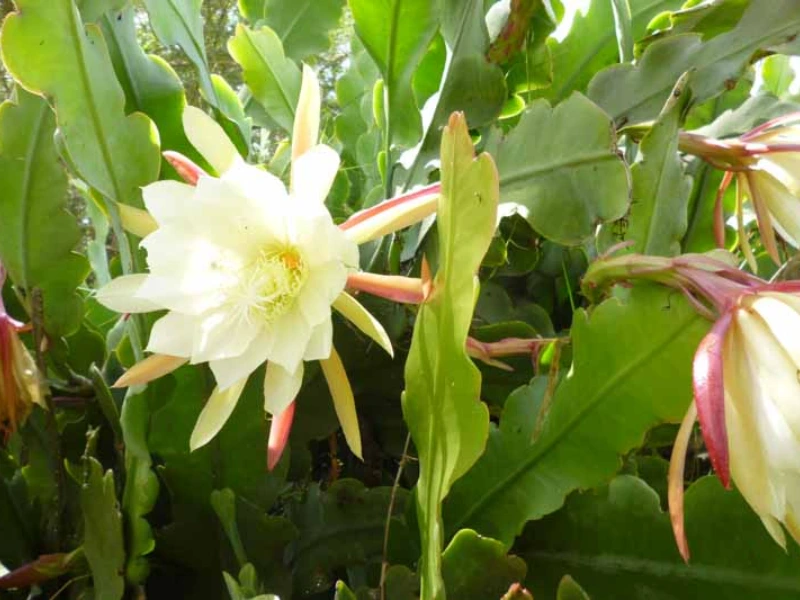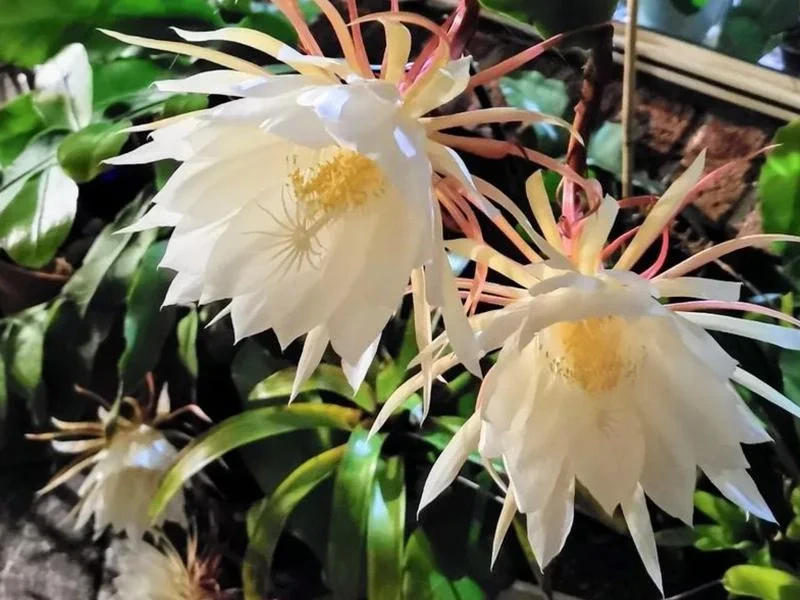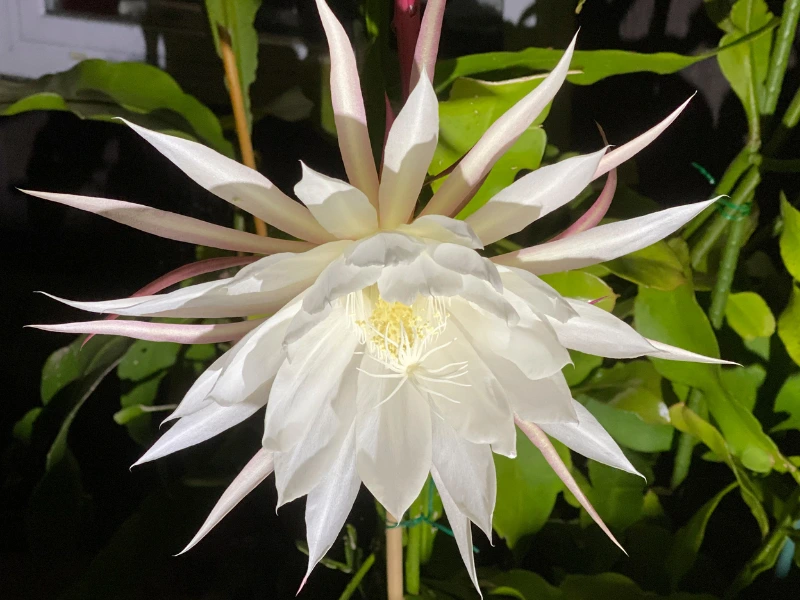Have You Ever Wondered Why Your Queen of the Night Cactus Won’t Bloom?
If you’ve been patiently waiting for your Queen of the Night cactus (also known as Epiphyllum Oxypetalum or night-blooming cereus) to bloom and nothing happens — you’re not alone! This exotic cactus is famous for its breathtaking, fragrant flowers that bloom for just one night. But without the right night blooming cereus care, you might wait years without seeing a single bloom.
Many plant enthusiasts are drawn to this unique plant because of its mystical blooming habits, but they often struggle to provide the optimal conditions for flowering. Improper watering, inadequate light, or the wrong soil can delay or completely prevent the flowering process. In this guide, I’ll walk you through everything — from planting, watering, and fertilizing to getting those blooms to pop open. Whether you’re growing indoors or outdoors, you’ll learn proven methods to care for your cactus and enjoy its spectacular blooms.
What is the Queen of the Night Cactus?

The Queen of the Night cactus, scientifically known as Epiphyllum Oxypetalum, belongs to the cactus family and is renowned for its show-stopping white flowers that bloom only at night. It’s commonly referred to as night-blooming cereus or tan hua, a name that evokes its enchanting floral display that lasts just a few hours.
Key Features
-
Scientific Name: Epiphyllum Oxypetalum
-
Common Names: Queen of the Night, Night Blooming Cereus, Tan Hua
-
Bloom Time: Once a year, typically during the summer
-
Flower Lifespan: Blooms last for only 6-12 hours, usually opening at night and wilting by dawn
-
Native Habitat: Tropical and subtropical regions, primarily found in Mexico and Central America
The allure of this cactus lies not only in its dramatic blooms but also in its symbolism in various cultures. In some traditions, the fleeting bloom is associated with good luck and spiritual awakening. Its rarity and beauty make it a prized possession for plant lovers who are willing to invest time and care to witness this botanical wonder.
Planting the Queen of the Night Cactus

Planting your Queen of the Night cactus correctly is the foundation for healthy growth and future blooms. Since this plant thrives in warm, humid conditions, ensuring the right environment is essential.
Best Time to Plant
The best time to plant Queen of the Night is during spring or early summer when temperatures stay consistently warm. This is when the plant is actively growing, making it easier for the roots to establish themselves. Avoid planting during winter or fall, as the plant may become dormant and growth may be stunted.
Choosing the Right Location
Choosing the right location can significantly impact the growth and blooming of your cactus. If you’re growing it indoors, place the plant near a bright, south-facing window where it can receive plenty of indirect sunlight. Too much direct sunlight can scorch the leaves, while too little light may prevent flowering.
If you’re growing the plant outdoors, especially in USDA zones 10-11, choose a partially shaded spot to protect it from the harsh afternoon sun. In cooler climates, consider bringing the plant indoors during the colder months to protect it from frost.
Soil Preparation
Proper soil preparation is critical to ensuring that your Queen of the Night cactus thrives. The plant prefers a well-draining soil mix that mimics its natural tropical environment.
-
Use a well-draining cactus mix with added organic matter.
-
A combination of cactus soil, perlite, and orchid bark works best to provide adequate aeration and drainage.
-
Maintain a slightly acidic to neutral soil pH between 5.5 and 6.5 for optimal growth.
Planting the Queen of the Night Cactus
When planting the Queen of the Night cactus, ensure that you bury the stem cutting about 1-2 inches into the prepared soil. Place the pot in a warm, humid location to encourage root development. Water sparingly until you see new growth, indicating that the roots have established.
Container Planting Tips
If you prefer growing your Queen of the Night cactus in a container, choose a pot with drainage holes to prevent water from accumulating at the bottom, which can lead to root rot. Hanging baskets work exceptionally well since the cactus has a sprawling growth habit, but ensure that the container is large enough to accommodate its growth over time.
Growing and Caring for the Queen of the Night Cactus

When it comes to night blooming cereus care, understanding the plant’s watering, fertilizing, and pruning needs is essential. Since this tropical cactus prefers warm and humid environments, it’s important to maintain a proper balance of moisture without overwatering.
Watering Guidelines
Watering is perhaps the most critical aspect of cactus care. Water deeply but allow the soil to dry out between watering sessions. During the growing season, which typically runs from spring to fall, water the plant every 7-10 days.
In the winter, reduce watering to once a month to prevent root rot. Overwatering is a common mistake that can lead to fungal diseases, so always ensure that the pot has good drainage.
Fertilizing Tips
To encourage healthy growth and vibrant blooms, fertilize the plant once a month during the growing season. Use a balanced 10-10-10 fertilizer diluted to half strength. Avoid fertilizing during winter, as the plant enters dormancy and does not require additional nutrients.
Pruning and Maintenance
Pruning helps maintain the shape of your plant and encourages new growth. After the flowers have faded, prune away spent blooms and any dead or yellowing leaves. This improves air circulation and prevents diseases from developing.
Seasonal Plant Care Tips
-
Spring: Increase watering and fertilizing to support new growth.
-
Summer: Monitor for blooming and reduce watering slightly after flowers fade.
-
Winter: Keep the cactus in a cool, dry location with minimal watering.
Potting and Repotting
Repot your Queen of the Night cactus every 2-3 years to refresh the soil and prevent root congestion. Choose a slightly larger pot and always use fresh cactus mix when repotting.
How to Propagate the Queen of the Night Cactus
The Queen of the Night Cactus is easy to propagate through cuttings. This is a great way to expand your cactus collection or share plants with friends and family.
Steps for Propagating Through Cuttings
-
Choose a healthy stem: Select a mature stem that’s free from damage.
-
Cut the stem: Use a clean, sharp knife to cut a 4-6 inch piece of the stem.
-
Let the cutting callous: Allow the cutting to dry for 1-2 days to prevent rot when planted.
-
Plant the cutting: Place the cutting into well-draining cactus soil, and lightly water it.
-
Wait for roots: In about 2-3 weeks, the cutting should root and begin growing.
How to Get the Queen of the Night Cactus to Bloom

Getting your Queen of the Night cactus to bloom requires patience and the right environmental conditions. Since the plant only blooms once a year, it’s essential to create an environment that mimics its natural habitat.
When Does It Bloom?
The Queen of the Night cactus blooms once a year, usually during summer. The bloom often occurs between June and July and lasts for only a few hours, making it a fleeting but unforgettable experience. The flowers typically begin to open at nightfall and reach full bloom by midnight, only to wither by the early hours of dawn.
The Irresistible Fragrance of the Bloom
One of the most captivating features of the Queen of the Night cactus flower is its heavenly fragrance. As the flowers unfurl under the moonlight, they release an intoxicating scent that fills the air. The aroma is often described as a blend of sweet vanilla and jasmine, with subtle hints of honey and a touch of citrus. It’s a rich, floral perfume that’s both delicate and powerful, lingering in the air long after the flower has closed.
For many plant enthusiasts, the scent of the Queen of the Night cactus is one of the main reasons they eagerly await its rare bloom. The fragrance is so strong that it can fill an entire room, making it a memorable experience for anyone fortunate enough to witness this nocturnal spectacle. Gardeners often say that the aroma evokes a sense of calm and wonder, adding an almost mystical quality to the moment.
How to Encourage Blooming
To increase the likelihood of blooming:
-
Reduce watering in winter: Allow a period of dryness to encourage blooming in the following season.
-
Provide bright light: Indirect sunlight during spring and summer helps stimulate flowering.
-
Maintain ideal temperatures: Keep the plant in temperatures ranging between 65-75°F (18-24°C).
By mimicking its natural growing conditions and providing the right amount of light, water, and nutrients, you can encourage your Queen of the Night cactus to bloom and reward yourself with its breathtaking flowers and unforgettable fragrance.
Troubleshooting Common Problems
Even with the best care, you may encounter some issues while growing your Queen of the Night cactus. Here are some common problems and how to fix them.
Common Pests and Diseases
-
Spider Mites: Leaves develop tiny webs and yellow spots. Treat with neem oil or insecticidal soap.
-
Mealybugs: Look for white, cotton-like residue on the leaves. Clean the leaves with rubbing alcohol to eliminate the pests.
-
Root Rot: Often caused by overwatering. Ensure the pot has adequate drainage to prevent this issue.
FAQs About Queen of the Night Cactus
- How often should I water Queen of the Night Cactus?
Water every 7-10 days during the growing season, ensuring the soil is completely dry before watering again. In winter, reduce watering to once a month, as the plant enters a dormant phase and requires less moisture. - Can I grow Queen of the Night indoors?
Yes, Queen of the Night Cactus can thrive indoors with proper care. Place it in bright indirect sunlight near a south-facing window, but avoid direct sunlight, as it can scorch the delicate cactus. - Why isn’t my Queen of the Night cactus blooming?
Lack of light, overwatering, or poor seasonal care can delay blooming. Ensure your cactus is receiving sufficient light, and avoid overwatering during the dormant winter months. Sometimes, the plant needs a bit of stress, such as slightly less water, to trigger blooming. - Is Queen of the Night cactus toxic to pets?
No, the Queen of the Night Cactus is non-toxic to pets. However, it’s always a good idea to keep plants out of reach of curious pets to avoid any accidental ingestion or damage to the plant.
Final Thoughts
Caring for the Queen of the Night cactus isn’t difficult, but patience is key. With the right balance of light, water, and care, you’ll be rewarded with its mesmerizing blooms. The joy of witnessing your plant bloom after months (or even years) of anticipation is truly a rewarding experience.
If you’re ready to experience the magic of night-blooming flowers, follow these steps and watch as your cactus transforms into a blooming masterpiece. Whether you’re a beginner or an experienced gardener, with proper care, your Queen of the Night cactus will reward you with one of nature’s most stunning spectacles.


7 Vegetables to Plant in December for a Bountiful Winter Harvest
Winter gardening is a challenge many new gardeners shy away from. But if you’re among [...]
Dec
9 Common Christmas Cactus Problems and How to Fix Them
Have you ever walked past your Christmas cactus and wondered why it suddenly looks sad? [...]
Nov
Swedish Ivy Care: How to Grow a Healthy, Thriving Plant
Have you ever looked at your Swedish Ivy and wondered why the leaves are turning [...]
Nov
Avoid These 10 Garlic Planting Mistakes for Bigger, Healthier Bulbs
Growing garlic at home is one of the most satisfying things a gardener can do [...]
Nov
How to Prevent Christmas Cactus Bud Drop: Tips for a Healthy Bloom
Have you ever noticed your beautiful Christmas cactus (Schlumbergera) starting to lose its buds just [...]
Nov
Discover 7 Stunning Types of Night-Blooming Cereus
Have you ever waited for a flower that only opens at night and then disappears [...]
Nov